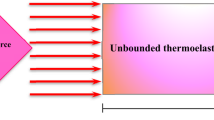Abstract
A new model of generalized thermoelasticity equations for isotropic media with temperature-dependent mechanical properties is established. The modulus of elasticity is taken as a linear function of reference temperature. The present model is described both generalizations, Lord-Shulman (L-S) theory with one relaxation time and Green-Lindsay (G-L) with two relaxation times, as well as the coupled theory, instantaneously. The method of the matrix exponential, which constitutes the basis of the state space approach of modern control theory, applied to two-dimensional equations. Laplace and Fourier integral transforms are used. The resulting formulation is applied to a problem of a thick plate subject to heating on parts of the upper and lower surfaces of the plate that varies exponentially with time. Numerical results are given and illustrated graphically for the problem considered. A comparison was made with the results obtained in case of temperature-independent modulus of elasticity in each theory.
Similar content being viewed by others
Abbreviations
- λ, μ:
-
Lamé constants
- ρ:
-
density
- C E :
-
specific heat at constant strain,
- k :
-
thermal conductivity
- ηo :
-
\( = \frac{{\rho c_E }}{k}\)
- E(T) :
-
temperature dependent modulus of elasticity
- T :
-
absolute temperature,
- t :
-
time,
- α* 0:
-
empirical material constant [1/K],
- α:
-
\( = \frac{1}{{1 - \alpha *T_o }}\),
- δ o :
-
non-dimensional constant for adjustment of the reference temperature,
- E o :
-
constant (modulus of elasticity at α*=0,
- α T :
-
coefficient of linear thermal expansion,
- ν:
-
Poisson's ratio,
- c 2 o :
-
\( = \frac{{\left( {\lambda _0 + 2\mu _o } \right)E_o }}{\rho } \)
- γ o :
-
\( = \frac{{\alpha _T }}{{1 - 2\nu }}\),
- T o :
-
reference temperature\(\frac{{\delta _o \rho c_o^2 }}{{\gamma _o {\rm E}_o }} = \frac{{\delta _o (1 - \nu )}}{{\alpha _T (1 + \nu )}}\),
- μ o :
-
\( = \frac{1}{{2(1 + \nu )}}\),
- λ o :
-
\( = \frac{\nu }{{(1 + \nu )(1 - 2\nu )}}\),
- β:
-
\( = \frac{{E_o \left( {\lambda _o + \mu _o } \right)}}{{\rho c_o^2 }} = \frac{1}{{2(1 - \nu )}}\),
- ∈1 :
-
\( = \frac{{\gamma _o {\rm E}_o }}{{\rho c_e }}\),
- ∈:
-
=∈1δo
- ∈ o :
-
=\( = \frac{ \in }{\alpha }\),
- ∈ ij :
-
components of the strain tensor,
- e :
-
∈ ij dilatation,
- u i :
-
components of the displacement vector,
- σ ij :
-
components of the stress tensor,
- τ o :
-
relaxation times,
- Q :
-
strength of the applied heat source per unit mass
References
W. Nowacki,Thermoelasticity, Addison-Wesley P. B. Com. Tnc. London, 1962.
A. Lomakin,The Theory of Elasticity of Non-Homogeneous Bodies. Ncew, 1976.
Y. Tanigawa,Some Basic Thermoelastic Problems for Non-Homogeneous Structural Materials, Appl. Mech. Rew.48 (1995).
Y. Dotao, T. Akai and Y. Tanigawa,Three-Dimensional Transient Thermal Stress Analysis Of an-Homogeneous Hollow Circular Cylinder Due to Moving Heat Source in the Axial Direction, J. Thermal Stresses18 (1995).
M. Biot,Thermoelasticity and Irreversible Thermodynamics, J. Appl. Phys.27 (1956), 240–253.
H. Lord and Y. Shulman,A Generalized Dynamical Theory of Thermoelasticity, J. Mech. Phys. Solid.15 (1967), 299–309.
I. Mller,The Coldness, a Universal Function in Thermo-Elastic Solids, Arch. Rat. Mech. Anal.41 (1971), 319–332.
A. Green and N. Laws,On the Entropy Production Inequality, Arch. Rat. Anal.54 (1972), 17–53.
A. Green and K. Lindsay,Thermoelasticity, J. Elast.2 (1972), 1–7.
E. Suhubi,Thermoelastic Solids, in: A. C. Eringen (ED), Cont. Phys II, Academic Press, New York, 1971 (Chapter 2).
L. Bahar, R. Hetnarski,State Space Approach to Theromelasticity, J. Thermal Stresses1 (1978), 135–146.
T. Honig, H. Hirdes,A Method for the Numerical Inversion of the Laplace transform, J. Comp. Appl. Math.10 (1984), 113–132.
M. Ezzat, M. Othman and A. El-Karamany,The Dependence of the Modulus of Elasticity on The Reference Temperature in Generalized Thermoelasticity, J. Thermal Stresses.24 (2001), 1159–1176.
Press, William H. et al.,Numerical recipes Cambridge: Cambridge University Press, 1986.
Author information
Authors and Affiliations
Corresponding author
Additional information
M. Zakaria received his BS from Alexandria University (1989) and Ph. D at Tanta University (1995). Since 1984, he has been at the university of Alexandria. His research interests “the non-Newtonian fluids in the presence of a magnetic field”. Also he interests research: a viscoelastic and micropolar fluids.
Rights and permissions
About this article
Cite this article
Ezzat, M., Zakaria, M. & Abdel-Bary, A. Generalized thermoelasticity with temperature dependent modulus of elasticity under three theories. JAMC 14, 193–212 (2004). https://doi.org/10.1007/BF02936108
Received:
Revised:
Issue Date:
DOI: https://doi.org/10.1007/BF02936108



